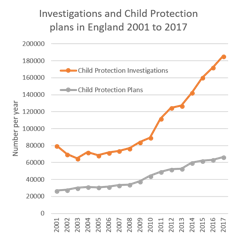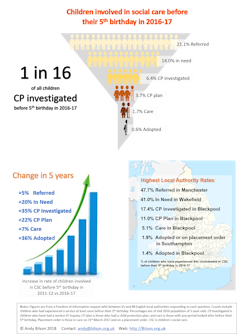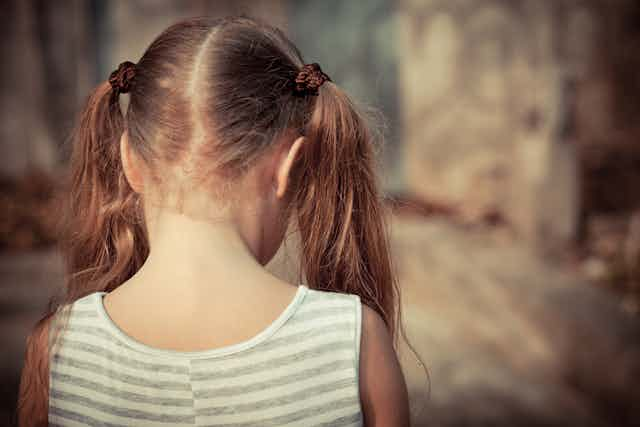Parents in English-speaking countries are now increasingly likely to be accused of abusing their children. This mainly affects large proportions of families who are poor, deprived or socially excluded. My new research shows how this trend is being played out in England and what’s behind it.
Despite similarities between child protection systems in English-speaking countries, their statistics are not directly comparable – but common trends within countries can be identified. The latest data shows increases in child protection investigations in Australia of 42% between 2012 to 2016, Canada, 74% between 1998 and 2008, and in the US, 17% between 2007 and 2015. In England between 2008 and 2017 investigations more than doubled (a 124.3% increase).

But in all these countries, investigations became less likely to actually find abuse. In England there was a fall between 2008 and 2017 from 44% to 36% of investigations finding harm and requiring what’s known as a “child protection plan”. Investigations not leading to a protection plan almost tripled from 42,800 to 119,040. On average in England in 2017 an investigation not leading to a protection plan started every four minutes and 40 seconds.
Why the increase?
Reasons for investigations have been studied in depth in Canada where, between 1998 and 2008, there was no change in urgent protection but a doubling of rates of children found to be in chronic need. In these cases, intervention was intended to prevent future harm mainly from neglect or emotional abuse.
England had similar trends between 2008 and 2017 with an increase in findings: 15% in sexual abuse cases and 26% in physical abuse, compared with a 164% in emotional abuse and 103% in neglect. Sexual and physical abuse together accounted for only 16% of the reasons for child protection plans in England in 2017.

Surprisingly there is little evidence that investigative child protection systems in these countries reduces maltreatment. One of the few studies compared six countries and found no consistent evidence for a reduction in maltreatment.
Similarly, my study of trends over 15 years in Western Australia found no change in the extent or type of harm recorded by social workers when abuse was substantiated. This was despite fluctuations in the number of reports, investigations and substantiations of abuse.
Children at risk
It might be thought that only a small minority of children are involved in child protection. But a recent study suggested that in the US, 37% of children are investigated before the age of 18. Studies in Australia and New Zealand found around a quarter of children were notified for child protection before the age of 18.
All these studies showed higher incidence of child protection involvement for excluded groups. In the US, over half of African-American children were investigated and similar rates were found for Aboriginal children in Australia and New Zealand.
Data on English child protection differs from those in other English-speaking countries as it covers both welfare and child protection, though this difference is narrowing. My earlier research showed that one in every five children is referred to children’s services before the age of five. This rate is doubled in deprived communities where children have a much higher chance of being involved.
Postcode lottery
My new research used a freedom of information request to show how children’s involvement in child protection is changing. The study looked at two groups of children and mapped their involvement in children’s services from birth to their fifth birthday between 2012 and 2017. During this time there was an increase of over 35% in the rate of children investigated and those adopted.
The research also found that before their fifth birthday in 2017, one in five children were referred, one in seven were “in need” and required a service to achieve a reasonable standard of health or development, and one in 16 were investigated.

There were also major differences between local authorities. In Manchester almost half of all children had been referred before the age of five – the highest rate in the study. The rate of investigations ranged from 17.4% in Blackpool to 2% in Hull and Stockport.
A ‘rescue culture’
There are several explanations for these rapid increases in England. Families are under stress because of increasing inequality. This increases factors associated with concerns about abuse including mental illness, drug and alcohol misuse, and child and parental ill-health. It creates stress in relationships making intimate violence – a key factor in emotional abuse – more likely. It also directly causes neglect because of parent’s inability to clothe, feed, house and otherwise look after children.
Austerity policies have dramatically reduced expenditure on support for families – particularly in the most deprived areas. While the government argues that quality services can still be delivered at a lower cost, it ignores the evidence to the contrary from its own inspection service.
Reactions to child deaths and government policies have also created a growing pressure to adopt a culture of child rescue rather than family support. And this has led to increasing separation of children from parents and a crisis in the family court system.
The postcode lottery shown by this research stems from a combination of these pressures and the extent that this “rescue culture” has taken hold. Whatever the cause, these changes have created a deteriorated environment for families in deprived communities who face more stress, less support and the highest ever risk of being accused of abusing their child and then losing them to care or adoption.

